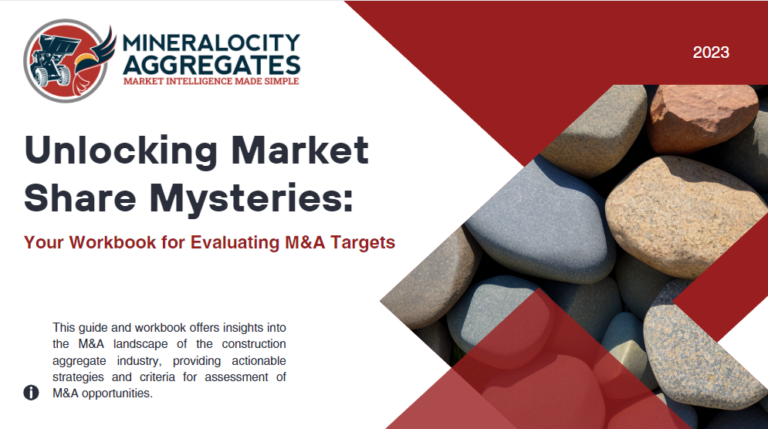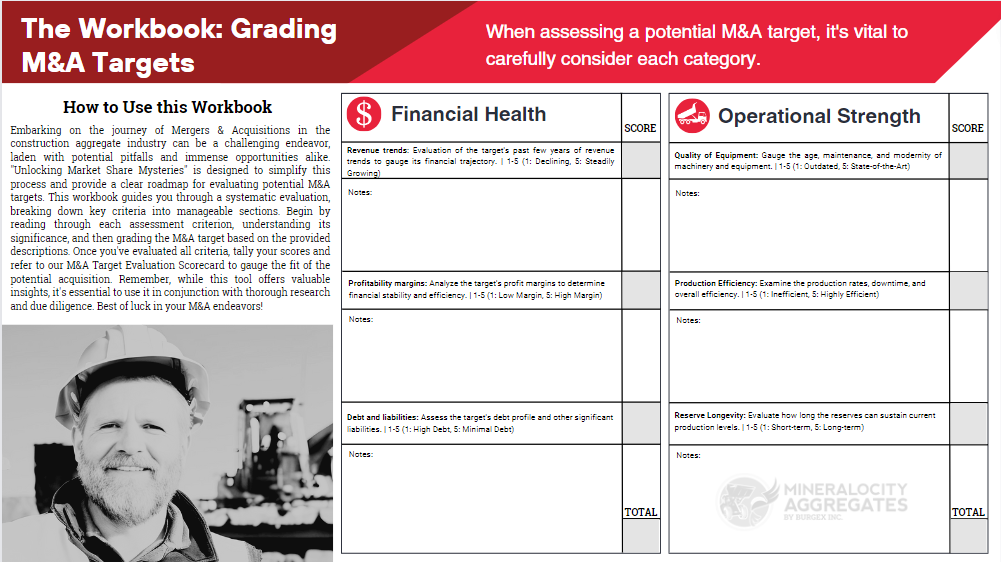The construction aggregate industry, grounded on the foundations of sand, gravel, and crushed stone, has more layers and nuances than it first appears. Beneath the surface gravel lies an ever-evolving world teeming with growth potential and promising M&A opportunities. With the landscape of the sector steadily changing, identifying the right merger and acquisition prospects becomes a treasure hunt. How does one differentiate true gems from mere stones? Lets dive in and explore M&A strategies in the aggregates industry!
1. Recognizing the Lay of the Land
Understanding the dynamics of the construction aggregate industry is the first step in any successful M&A venture. With projections indicating a CAGR of 4.2% from 2022 to 2028, it’s clear that the sector is on an upward trajectory. This growth is powered by the rising tide of investments in infrastructure, burgeoning residential construction, and expansive commercial development.
Additionally, regional nuances play a significant role in influencing demand. For instance, the western and southern parts of the U.S. are experiencing heightened levels of population growth and economic development, driving a surge in demand for aggregates. When exploring M&A possibilities, a nuanced approach that accounts for regional growth pockets can be invaluable. By aligning acquisition strategies with these growth zones, businesses can position themselves in the heart of the action.
2. Financial Stability: More Than Just Profit Margins
While a healthy profit margin is undoubtedly attractive, it’s essential to delve deeper to grasp the entire financial narrative of a potential acquisition target. Steady revenue trends, for instance, can indicate a consistent client base and market demand. This consistency can provide a cushion during economic downturns and industry fluctuations.
Furthermore, understanding a company’s debt structures and liabilities is paramount. Excessive debt, especially if not backed by tangible assets or growth strategies, can be a red flag, signaling potential financial distress down the line. Conversely, a company with manageable liabilities and a sound debt strategy can indicate prudent financial management, which will be a boon in the post-acquisition phase. In essence, it’s about identifying companies that offer not just short-term gains but long-term financial stability.
3. Operational Excellence: The Real Money-Saver
The efficacy of a company’s operations can significantly influence its valuation and post-acquisition integration. Companies with state-of-the-art machinery and equipment, for example, might have a competitive edge, reducing the need for immediate capital expenditure post-acquisition.
Equally vital is production efficiency. A company with a proven track record of maximizing output, minimizing waste, and efficiently utilizing resources can be a goldmine. Such operational efficiencies not only result in immediate cost savings but also pave the way for scaling the business in the future.
Lastly, reserve longevity should never be overlooked. In the aggregate industry, having access to long-term reserves ensures that operations aren’t interrupted, maintaining consistent supply lines. Companies with proven reserves can thus provide an added layer of security for potential investors or acquirers.
4. Assessing Market Position: One of the most important M&A strategies in the aggregates industry
Market position is often a testament to a company’s ability to effectively respond to industry dynamics. Firms with a significant market share have likely demonstrated adaptability, resilience, and business acumen. A strong reputation often precedes these successful firms, signaling consistent product quality and reliable service. One of the best M&A strategies in the aggregates industry is to identify opportunities where there are excellent markets that aren’t being adequately met. This is where Mineralocity Aggregates is indispensable.
Brand value is another indispensable metric. While the tangible assets of a company in the aggregates sector are clearly crucial, intangible assets like brand recognition can provide a competitive edge. Brands that resonate well with clients might find it easier to enter new markets or introduce new offerings.
Moreover, customer relationships and contracts are the lifeblood of any organization. Long-term contracts can offer predictable revenue streams, while a diverse customer base might indicate a company’s versatility and its ability to cater to varied market segments. When assessing M&A targets, firms with deep-rooted customer relationships can be particularly enticing, as they offer not just immediate financial gains but also strategic leverage in the market.
5. Navigating Regulatory and Environmental Landmines
In today’s environment-conscious world, regulatory and environmental considerations can’t be brushed aside. Companies that have a clear permitting status demonstrate foresight, preparedness, and an adherence to industry standards, reducing potential post-acquisition complications.
Environmental commitments, in turn, can be a beacon for brand image. Firms that are not just compliant but also proactively engage in environmentally-friendly practices signal a forward-thinking mindset. Such companies are more likely to be favored by both clients and potential partners who are increasingly seeking sustainable solutions.
Further, a company’s safety and compliance record can be seen as a reflection of its corporate culture and priorities. A clean record is indicative of an organization that values its employees, operates responsibly, and anticipates potential risks—traits that can significantly smooth the post-merger integration process. It’s easy to pull up an operating mines safety record from MSHA – this should be one of the first steps in the M&A process, don’t wait for the potential seller to provide this critical information.
6. Personnel and Culture: The Heart and Soul of an Enterprise
Beyond the machinery and financial figures lies the true essence of any organization: its people. The expertise and talent within a team can be the difference between a seamlessly integrated acquisition and a challenging merger. Firms with knowledgeable teams bring in not just operational know-how but also deep industry insights, potentially opening doors to innovative strategies and practices.
Cultural fit, often underestimated, can be the linchpin of a successful merger. Companies with aligned values, goals, and operating philosophies find the integration process more organic, leading to reduced friction and enhanced collaboration.
Leadership and management competencies further elevate the value of an acquisition target. Strong leaders who have steered their firms through industry challenges bring a wealth of experience, potentially aiding in the strategic direction of the merged entity. Identifying companies with visionary leaders can, thus, be a boon for long-term growth and stability.
A Treasure Trove of Insights into M&A strategies in the aggregates industry Await!
For those looking to navigate the intricate pathways of M&A strategies in the aggregates industry, our newly released M&A guide and workbook offers a roadmap. From understanding the nuances of the industry to a comprehensive due diligence checklist, this guide is an indispensable resource for firms serious about M&A success.
Ready to take the plunge? Download the M&A Guide and Workbook below and set your sights on the industry’s most promising prospects.


Are You Prepared to Master the Art of Aggregate M&A Target Evaluation?
Unlock the secrets of successful M&A in the aggregates industry with our comprehensive workbook. Packed with actionable insights, best practices, and strategic tools, this guide is your blueprint for making informed, profitable decisions.
Don’t miss your chance to elevate your M&A game—download now!


